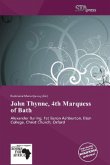High Quality Content by WIKIPEDIA articles! Marquess of Bath is a title in the Peerage of Great Britain. It was created in 1789 for Thomas Thynne, 3rd Viscount Weymouth. The Thynne family descends from the soldier and courtier Sir John Thynne (died 1580), who constructed Longleat House between 1567 and 1579. In 1641 his great-grandson Henry Frederick Thynne was created a Baronet, of Cause Castle, in the Baronetage of England (some sources claim that the territorial designation is "Kempsford in the County of Gloucester"). He was succeeded by his son, the second Baronet. He represented Oxford University and Tamworth in the House of Commons and also served as Envoy to Sweden. In 1682 he was raised to the Peerage of England as Baron Thynne, of Warminster in the County of Wiltshire, and Viscount Weymouth, in the County of Dorset, with remainder to his younger brothers James Thynne (who died unmarried) and Henry Frederick Thynne and the heirs male of their bodies.
Bitte wählen Sie Ihr Anliegen aus.
Rechnungen
Retourenschein anfordern
Bestellstatus
Storno








